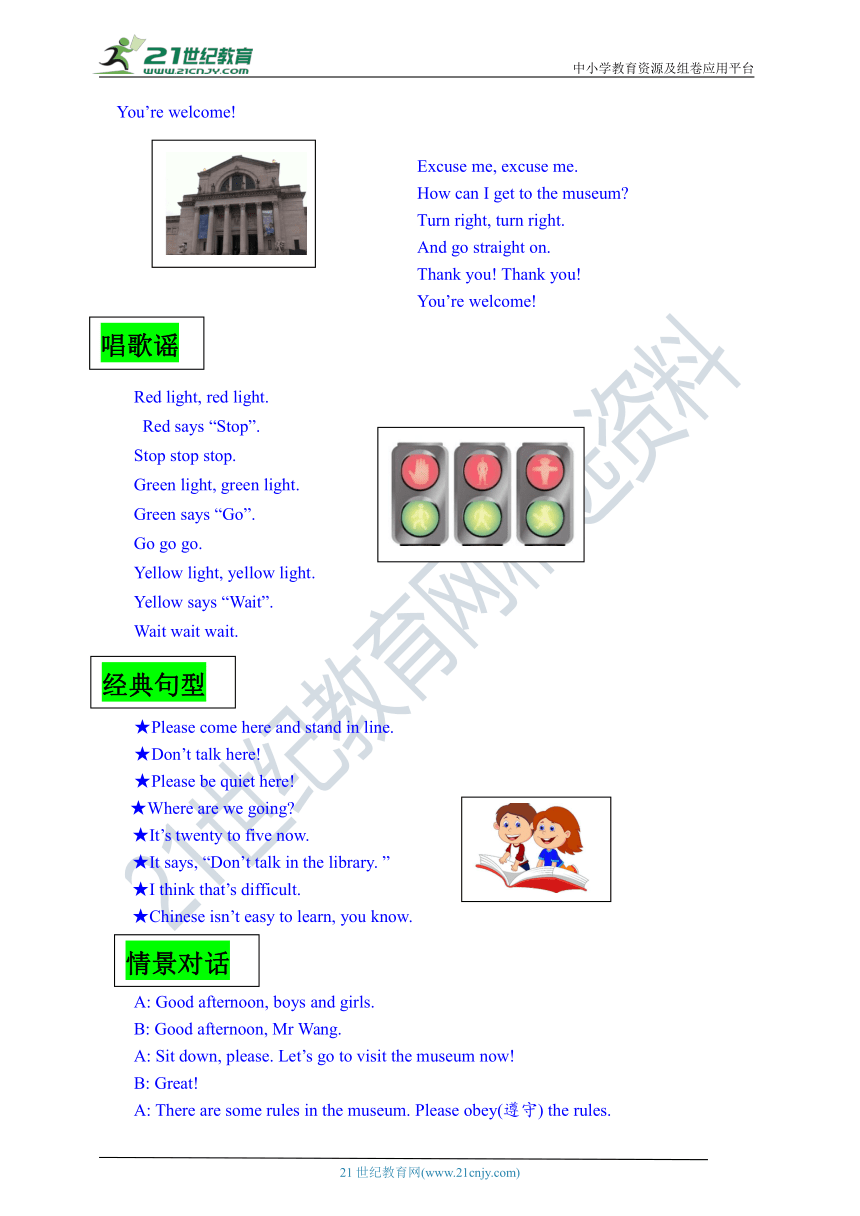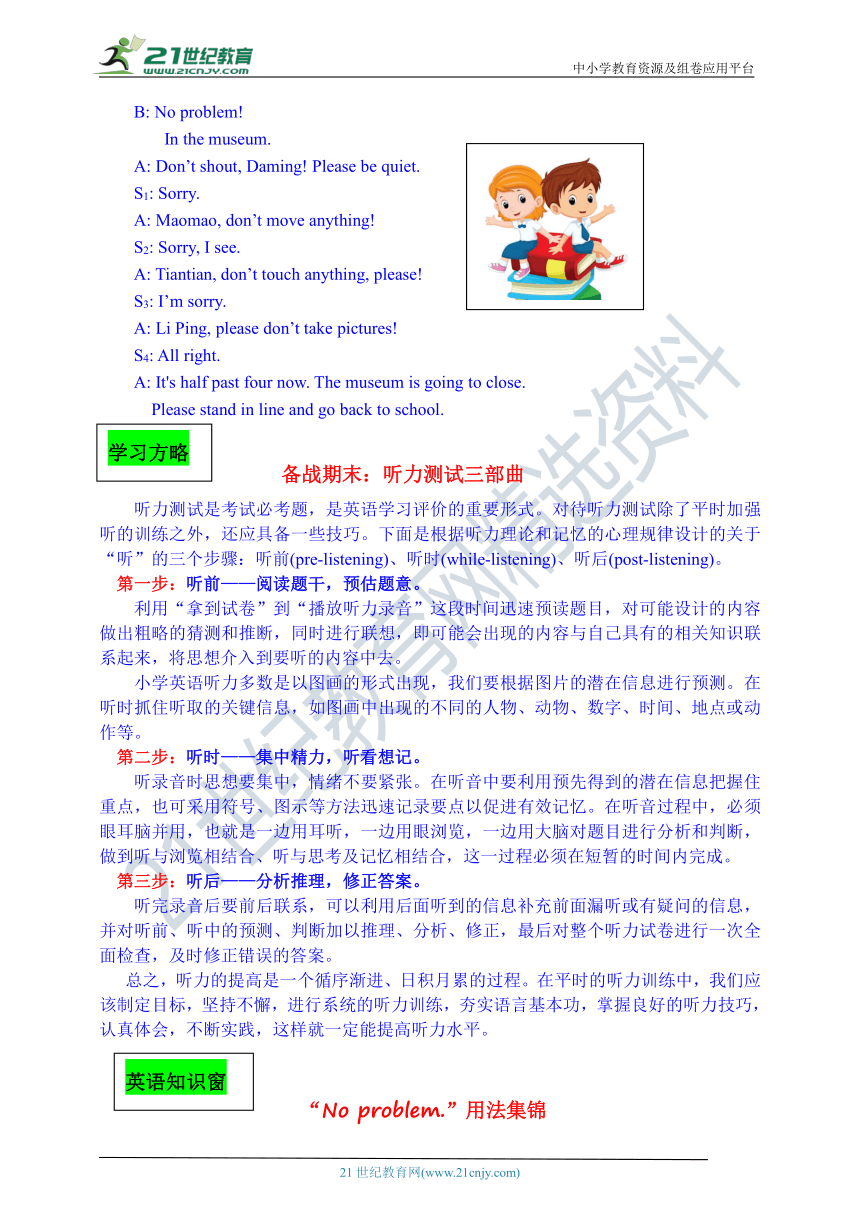外研版(三年级起点)六年级上学期用Module 10趣味英语读和练(含答案)
文档属性
| 名称 | 外研版(三年级起点)六年级上学期用Module 10趣味英语读和练(含答案) |  | |
| 格式 | doc | ||
| 文件大小 | 2.4MB | ||
| 资源类型 | 试卷 | ||
| 版本资源 | 外研版(三年级起点) | ||
| 科目 | 英语 | ||
| 更新时间 | 2021-11-25 15:42:57 | ||
图片预览



文档简介
中小学教育资源及组卷应用平台
Module 10
交际用语。行为和习惯。发出指令、执行指令。指路。祈使句。
掌握祈使句的基本用法。掌握和运用祈使句句型。使用祈使句发出指令或执行指令。
通过交际化语言的学习,提高学习英语的热情,树立学习英语的自信心。积极与他人合作,享受沟通乐趣,共同完成学习任务;能积极运用所学知识进行表达和交流;能在学习新知中锻炼自我的探究能力。培养听说读写的能力。养成遵守规章制度的好习惯,培养良好的品德和素质。热心帮助他人,助人为乐。
交通灯是用来指挥交通通行的信号灯,通常由红黄绿三种颜色灯组成。
19世纪初,在英国中部的约克城,红绿装分别代表女性的不同身份。着红装的女人表示已婚者,而着绿装的女人则表示未婚者。后来,英国伦敦威斯敏斯会议大楼前经常发生马车轧人的事故,于是人们受到红绿装启发,1868年12月10日,英国铁路信号工程师德 哈特设计、制造了世上第一盏信号灯,灯柱高7米,身上挂着一盏红绿两色的提灯——煤气交通信号灯。在灯的脚下,一名手持长杆的警察随心所欲地牵动皮带转换提灯的颜色。后来在信号灯的中心装上煤气灯罩,它的前面有两块红、绿玻璃交替遮挡。不幸的是只面世23天的煤气灯突然爆炸自灭,使一位正在值勤的警察也因此断送了性命。从此,城市的交通信号灯被取缔了。直到1914年,在美国的克利夫兰市才率先恢复了红绿灯,不过,这时已是“电气信号灯”。稍后又在纽约和芝加哥等城市,相继重新出现了交通信号灯。
随着各种交通工具的发展和交通指挥的需要,第一盏名副其实的三色灯(红黄绿)于1918年诞生。它是三色圆形四面投影器,被安装在纽约市五号街的一座高塔上。它的诞生,使城市交通大为改善。
Excuse me, excuse me.
How can I get to the library
Turn left, turn left.
And go straight on.
Thank you! Thank you!
You’re welcome!
Excuse me, excuse me.
How can I get to the museum
Turn right, turn right.
And go straight on.
Thank you! Thank you!
You’re welcome!
Red light, red light.
Red says “Stop”.
Stop stop stop.
Green light, green light.
Green says “Go”.
Go go go.
Yellow light, yellow light.
Yellow says “Wait”.
Wait wait wait.
★Please come here and stand in line.
★Don’t talk here!
★Please be quiet here!
★Where are we going
★It’s twenty to five now.
★It says, “Don’t talk in the library. ”
★I think that’s difficult.
★Chinese isn’t easy to learn, you know.
A: Good afternoon, boys and girls.
B: Good afternoon, Mr Wang.
A: Sit down, please. Let’s go to visit the museum now!
B: Great!
A: There are some rules in the museum. Please obey(遵守) the rules.
B: No problem!
In the museum.
A: Don’t shout, Daming! Please be quiet.
S1: Sorry.
A: Maomao, don’t move anything!
S2: Sorry, I see.
A: Tiantian, don’t touch anything, please!
S3: I’m sorry.
A: Li Ping, please don’t take pictures!
S4: All right.
A: It's half past four now. The museum is going to close.
Please stand in line and go back to school.
备战期末:听力测试三部曲
听力测试是考试必考题,是英语学习评价的重要形式。对待听力测试除了平时加强听的训练之外,还应具备一些技巧。下面是根据听力理论和记忆的心理规律设计的关于“听”的三个步骤:听前(pre-listening)、听时(while-listening)、听后(post-listening)。
第一步:听前——阅读题干,预估题意。
利用“拿到试卷”到“播放听力录音”这段时间迅速预读题目,对可能设计的内容做出粗略的猜测和推断,同时进行联想,即可能会出现的内容与自己具有的相关知识联系起来,将思想介入到要听的内容中去。
小学英语听力多数是以图画的形式出现,我们要根据图片的潜在信息进行预测。在听时抓住听取的关键信息,如图画中出现的不同的人物、动物、数字、时间、地点或动作等。
第二步:听时——集中精力,听看想记。
听录音时思想要集中,情绪不要紧张。在听音中要利用预先得到的潜在信息把握住重点,也可采用符号、图示等方法迅速记录要点以促进有效记忆。在听音过程中,必须眼耳脑并用,也就是一边用耳听,一边用眼浏览,一边用大脑对题目进行分析和判断,做到听与浏览相结合、听与思考及记忆相结合,这一过程必须在短暂的时间内完成。
第三步:听后——分析推理,修正答案。
听完录音后要前后联系,可以利用后面听到的信息补充前面漏听或有疑问的信息,并对听前、听中的预测、判断加以推理、分析、修正,最后对整个听力试卷进行一次全面检查,及时修正错误的答案。
总之,听力的提高是一个循序渐进、日积月累的过程。在平时的听力训练中,我们应该制定目标,坚持不懈,进行系统的听力训练,夯实语言基本功,掌握良好的听力技巧,认真体会,不断实践,这样就一定能提高听力水平。
“No problem.”用法集锦
“No problem.”是一个使用频率很高的口语,在不同的情境下,其用法也不一样。现归纳如下:
1. 用来表示同意或愉快地回答请求,意为:没问题;小事一桩。例如:
A: Could you carry this box for me 请帮我搬这个箱子好吗
B: No problem. 没问题。
2. 用来表示有能力做某事,意为:没问题;不在话下。例如:
A: Can you make cakes 你会做蛋糕吗?
B: No problem. 没问题。
3. 用来回答感谢,意为:不用谢; 别客气;没什么。例如:
A: Thank you very much. 非常感谢你。
B: No problem. 不用谢。
4. 用来回答道歉,意为:没关系;没什么。例如:
A: Sorry to keep you waiting. 很抱歉让你等候。
B: No problem. 没关系。
5. 用来表示安慰,意为:没问题;那不成问题。例如:
A: I’ve left my money at home. 我把钱忘在家里了。
B: No problem. I can lend you money. 没问题。我可以借钱给你。
源于运动的“line”习语
在英语习语表达中,line可是个很多用的词汇,不仅仅是绳索,路线或球场上的边界线,line还有更加丰富而有趣的表达。咋们一起来看看吧!
★draw the line 字面意为“画线”,该习语可能源于最初的球类运动或拳击运动,在比赛时以界定线为标准。后引申为“ 划清界线”或“(因不赞同)拒绝做某事”。例如:
We must draw the line between the two.
我们必须在两者之间划清界限。
Some parents draw the line at talking about their children.
有些父母拒绝谈论他们的孩子。
★cross the line 字面意为“跨线”,该习语可能源于拳击比赛,在过去的拳击比赛中,双方选手都不可跨过地上的红线。后引申为“越界;过分”。例如:
I will never cross the line like that.
我永远不会干那么过分的事。
我会选
( )1.The light is red, you must _______.
A. go B. stop
( )2. — Don’t talk in class. — _______
A. OK. B. Oh, sorry.
( )3. — Can you help me make a kite
— _______
A. No problem. B. Yes, I can.
六年级上重点句子
★It’s more than twenty thousand kilometres long.
★Tell me more about the Great Wall.
★How long is it
★It’s really long!
★Can you tell me something about New York
★Beijing has got about twenty million people.
★It’s in the east of China.
★What a big map of the US!
★There’s a Chinatown in New York.
★Are there any Chinatowns in China
★Do you want to go to Chinatown
★There are lots of Chinese shops and restaurants there.
★You do miss China!
★Collecting stamps is my hobby.
★Have you got any stamps from China
★What’s your hobby
★What do you do on Flag Day
★That sounds nice.
★I think I like Thanksgiving too!
★Can you be my Chinese pen friend
★Pleased to meet you!
★Can you speak English
★Can I write to your friends
★I can’t write in Chinese.
★What book have you got
★Have you got a Chinese kite or a Japanese kite
★I’ve got a knife and fork, and chopsticks.
★I’ve got a stamp from China, but I haven’t got a stamp from Canada.
★It’s difficult for me.
★I live in New York, but I am not American.
★Please write to me and we can be pen friends.
★Daming says he will write to you soon.
★Grandma gives Daming a present.
★I don’t believe it!
★The snake can use its body to dance.
★Why does the snake come out of the box
★It says snakes can't hear.
★They think the flute is dangerous!
★Do you like reading books now
★Do you often clean your room
★He often takes photos of me.
★Did he show you his photos in China
★He’s flying to China now.
★I think we should go to all these places.
★Please come here and stand in line.
★Don’t talk here!
★It says, “Don’t talk in the library. ”
★Chinese isn’t easy to learn, you know.
“考点演练”参考答案
Module 10
1. B 2. B 3. A
话题和目标
Traffic lights
背景知识
Chant
唱歌谣
经典句型
情景对话
学习方略
英语知识窗
英语加油站
请在词典里查找下面句子里的生词,然后根据句子的意思,猜一个英语单词。
I work in the library. My duty is to manage books. I can lend the books to you. Do you know what my job is
Answer: ____________.
趣味英语
考点演练
“趣味英语”参考答案
Module 10:librarian
21世纪教育网 www.21cnjy.com 精品试卷·第 2 页 (共 2 页)
HYPERLINK "http://21世纪教育网(www.21cnjy.com)
" 21世纪教育网(www.21cnjy.com)
Module 10
交际用语。行为和习惯。发出指令、执行指令。指路。祈使句。
掌握祈使句的基本用法。掌握和运用祈使句句型。使用祈使句发出指令或执行指令。
通过交际化语言的学习,提高学习英语的热情,树立学习英语的自信心。积极与他人合作,享受沟通乐趣,共同完成学习任务;能积极运用所学知识进行表达和交流;能在学习新知中锻炼自我的探究能力。培养听说读写的能力。养成遵守规章制度的好习惯,培养良好的品德和素质。热心帮助他人,助人为乐。
交通灯是用来指挥交通通行的信号灯,通常由红黄绿三种颜色灯组成。
19世纪初,在英国中部的约克城,红绿装分别代表女性的不同身份。着红装的女人表示已婚者,而着绿装的女人则表示未婚者。后来,英国伦敦威斯敏斯会议大楼前经常发生马车轧人的事故,于是人们受到红绿装启发,1868年12月10日,英国铁路信号工程师德 哈特设计、制造了世上第一盏信号灯,灯柱高7米,身上挂着一盏红绿两色的提灯——煤气交通信号灯。在灯的脚下,一名手持长杆的警察随心所欲地牵动皮带转换提灯的颜色。后来在信号灯的中心装上煤气灯罩,它的前面有两块红、绿玻璃交替遮挡。不幸的是只面世23天的煤气灯突然爆炸自灭,使一位正在值勤的警察也因此断送了性命。从此,城市的交通信号灯被取缔了。直到1914年,在美国的克利夫兰市才率先恢复了红绿灯,不过,这时已是“电气信号灯”。稍后又在纽约和芝加哥等城市,相继重新出现了交通信号灯。
随着各种交通工具的发展和交通指挥的需要,第一盏名副其实的三色灯(红黄绿)于1918年诞生。它是三色圆形四面投影器,被安装在纽约市五号街的一座高塔上。它的诞生,使城市交通大为改善。
Excuse me, excuse me.
How can I get to the library
Turn left, turn left.
And go straight on.
Thank you! Thank you!
You’re welcome!
Excuse me, excuse me.
How can I get to the museum
Turn right, turn right.
And go straight on.
Thank you! Thank you!
You’re welcome!
Red light, red light.
Red says “Stop”.
Stop stop stop.
Green light, green light.
Green says “Go”.
Go go go.
Yellow light, yellow light.
Yellow says “Wait”.
Wait wait wait.
★Please come here and stand in line.
★Don’t talk here!
★Please be quiet here!
★Where are we going
★It’s twenty to five now.
★It says, “Don’t talk in the library. ”
★I think that’s difficult.
★Chinese isn’t easy to learn, you know.
A: Good afternoon, boys and girls.
B: Good afternoon, Mr Wang.
A: Sit down, please. Let’s go to visit the museum now!
B: Great!
A: There are some rules in the museum. Please obey(遵守) the rules.
B: No problem!
In the museum.
A: Don’t shout, Daming! Please be quiet.
S1: Sorry.
A: Maomao, don’t move anything!
S2: Sorry, I see.
A: Tiantian, don’t touch anything, please!
S3: I’m sorry.
A: Li Ping, please don’t take pictures!
S4: All right.
A: It's half past four now. The museum is going to close.
Please stand in line and go back to school.
备战期末:听力测试三部曲
听力测试是考试必考题,是英语学习评价的重要形式。对待听力测试除了平时加强听的训练之外,还应具备一些技巧。下面是根据听力理论和记忆的心理规律设计的关于“听”的三个步骤:听前(pre-listening)、听时(while-listening)、听后(post-listening)。
第一步:听前——阅读题干,预估题意。
利用“拿到试卷”到“播放听力录音”这段时间迅速预读题目,对可能设计的内容做出粗略的猜测和推断,同时进行联想,即可能会出现的内容与自己具有的相关知识联系起来,将思想介入到要听的内容中去。
小学英语听力多数是以图画的形式出现,我们要根据图片的潜在信息进行预测。在听时抓住听取的关键信息,如图画中出现的不同的人物、动物、数字、时间、地点或动作等。
第二步:听时——集中精力,听看想记。
听录音时思想要集中,情绪不要紧张。在听音中要利用预先得到的潜在信息把握住重点,也可采用符号、图示等方法迅速记录要点以促进有效记忆。在听音过程中,必须眼耳脑并用,也就是一边用耳听,一边用眼浏览,一边用大脑对题目进行分析和判断,做到听与浏览相结合、听与思考及记忆相结合,这一过程必须在短暂的时间内完成。
第三步:听后——分析推理,修正答案。
听完录音后要前后联系,可以利用后面听到的信息补充前面漏听或有疑问的信息,并对听前、听中的预测、判断加以推理、分析、修正,最后对整个听力试卷进行一次全面检查,及时修正错误的答案。
总之,听力的提高是一个循序渐进、日积月累的过程。在平时的听力训练中,我们应该制定目标,坚持不懈,进行系统的听力训练,夯实语言基本功,掌握良好的听力技巧,认真体会,不断实践,这样就一定能提高听力水平。
“No problem.”用法集锦
“No problem.”是一个使用频率很高的口语,在不同的情境下,其用法也不一样。现归纳如下:
1. 用来表示同意或愉快地回答请求,意为:没问题;小事一桩。例如:
A: Could you carry this box for me 请帮我搬这个箱子好吗
B: No problem. 没问题。
2. 用来表示有能力做某事,意为:没问题;不在话下。例如:
A: Can you make cakes 你会做蛋糕吗?
B: No problem. 没问题。
3. 用来回答感谢,意为:不用谢; 别客气;没什么。例如:
A: Thank you very much. 非常感谢你。
B: No problem. 不用谢。
4. 用来回答道歉,意为:没关系;没什么。例如:
A: Sorry to keep you waiting. 很抱歉让你等候。
B: No problem. 没关系。
5. 用来表示安慰,意为:没问题;那不成问题。例如:
A: I’ve left my money at home. 我把钱忘在家里了。
B: No problem. I can lend you money. 没问题。我可以借钱给你。
源于运动的“line”习语
在英语习语表达中,line可是个很多用的词汇,不仅仅是绳索,路线或球场上的边界线,line还有更加丰富而有趣的表达。咋们一起来看看吧!
★draw the line 字面意为“画线”,该习语可能源于最初的球类运动或拳击运动,在比赛时以界定线为标准。后引申为“ 划清界线”或“(因不赞同)拒绝做某事”。例如:
We must draw the line between the two.
我们必须在两者之间划清界限。
Some parents draw the line at talking about their children.
有些父母拒绝谈论他们的孩子。
★cross the line 字面意为“跨线”,该习语可能源于拳击比赛,在过去的拳击比赛中,双方选手都不可跨过地上的红线。后引申为“越界;过分”。例如:
I will never cross the line like that.
我永远不会干那么过分的事。
我会选
( )1.The light is red, you must _______.
A. go B. stop
( )2. — Don’t talk in class. — _______
A. OK. B. Oh, sorry.
( )3. — Can you help me make a kite
— _______
A. No problem. B. Yes, I can.
六年级上重点句子
★It’s more than twenty thousand kilometres long.
★Tell me more about the Great Wall.
★How long is it
★It’s really long!
★Can you tell me something about New York
★Beijing has got about twenty million people.
★It’s in the east of China.
★What a big map of the US!
★There’s a Chinatown in New York.
★Are there any Chinatowns in China
★Do you want to go to Chinatown
★There are lots of Chinese shops and restaurants there.
★You do miss China!
★Collecting stamps is my hobby.
★Have you got any stamps from China
★What’s your hobby
★What do you do on Flag Day
★That sounds nice.
★I think I like Thanksgiving too!
★Can you be my Chinese pen friend
★Pleased to meet you!
★Can you speak English
★Can I write to your friends
★I can’t write in Chinese.
★What book have you got
★Have you got a Chinese kite or a Japanese kite
★I’ve got a knife and fork, and chopsticks.
★I’ve got a stamp from China, but I haven’t got a stamp from Canada.
★It’s difficult for me.
★I live in New York, but I am not American.
★Please write to me and we can be pen friends.
★Daming says he will write to you soon.
★Grandma gives Daming a present.
★I don’t believe it!
★The snake can use its body to dance.
★Why does the snake come out of the box
★It says snakes can't hear.
★They think the flute is dangerous!
★Do you like reading books now
★Do you often clean your room
★He often takes photos of me.
★Did he show you his photos in China
★He’s flying to China now.
★I think we should go to all these places.
★Please come here and stand in line.
★Don’t talk here!
★It says, “Don’t talk in the library. ”
★Chinese isn’t easy to learn, you know.
“考点演练”参考答案
Module 10
1. B 2. B 3. A
话题和目标
Traffic lights
背景知识
Chant
唱歌谣
经典句型
情景对话
学习方略
英语知识窗
英语加油站
请在词典里查找下面句子里的生词,然后根据句子的意思,猜一个英语单词。
I work in the library. My duty is to manage books. I can lend the books to you. Do you know what my job is
Answer: ____________.
趣味英语
考点演练
“趣味英语”参考答案
Module 10:librarian
21世纪教育网 www.21cnjy.com 精品试卷·第 2 页 (共 2 页)
HYPERLINK "http://21世纪教育网(www.21cnjy.com)
" 21世纪教育网(www.21cnjy.com)
同课章节目录
- Module 1
- Unit 1 It's more than twenty thousand kilometers l
- Unit 2 It's in the west.
- Module 2
- Unit 1 There's Chinese dancing.
- Unit 2 There are lots of beautiful lakes in China.
- Module 3
- Unit 1 Collecting stamps is my hobby.
- Unit 2 What's your hobby?
- Module 4
- Unit 1 Thanksgiving is my favourite festival.
- Unit 2 Our favourite festival is the Spring Festiv
- Module 5
- Unit 1 Can you be my Chinese pen friend?
- Unit 2 I can speak French.
- Module 6
- Unit 1 You've got a letter from New York.
- Unit 2 I've got a stamp from China.
- Module 7
- Unit 1 I don't believe it.
- Unit 2 Pandas love bamboo.
- Module 8
- Unit 1 Do you often play with dolls?
- Unit 2 I often go swimming.
- Module 9
- Unit 1 Do you want to visit the UN building?
- Unit 2 I want to go to Shanghai.
- Review Module
- Unit 1
- Unit 2
- Module 10
- Unit 1 Don't talk in the library.
- Unit 2 Go straight on!
